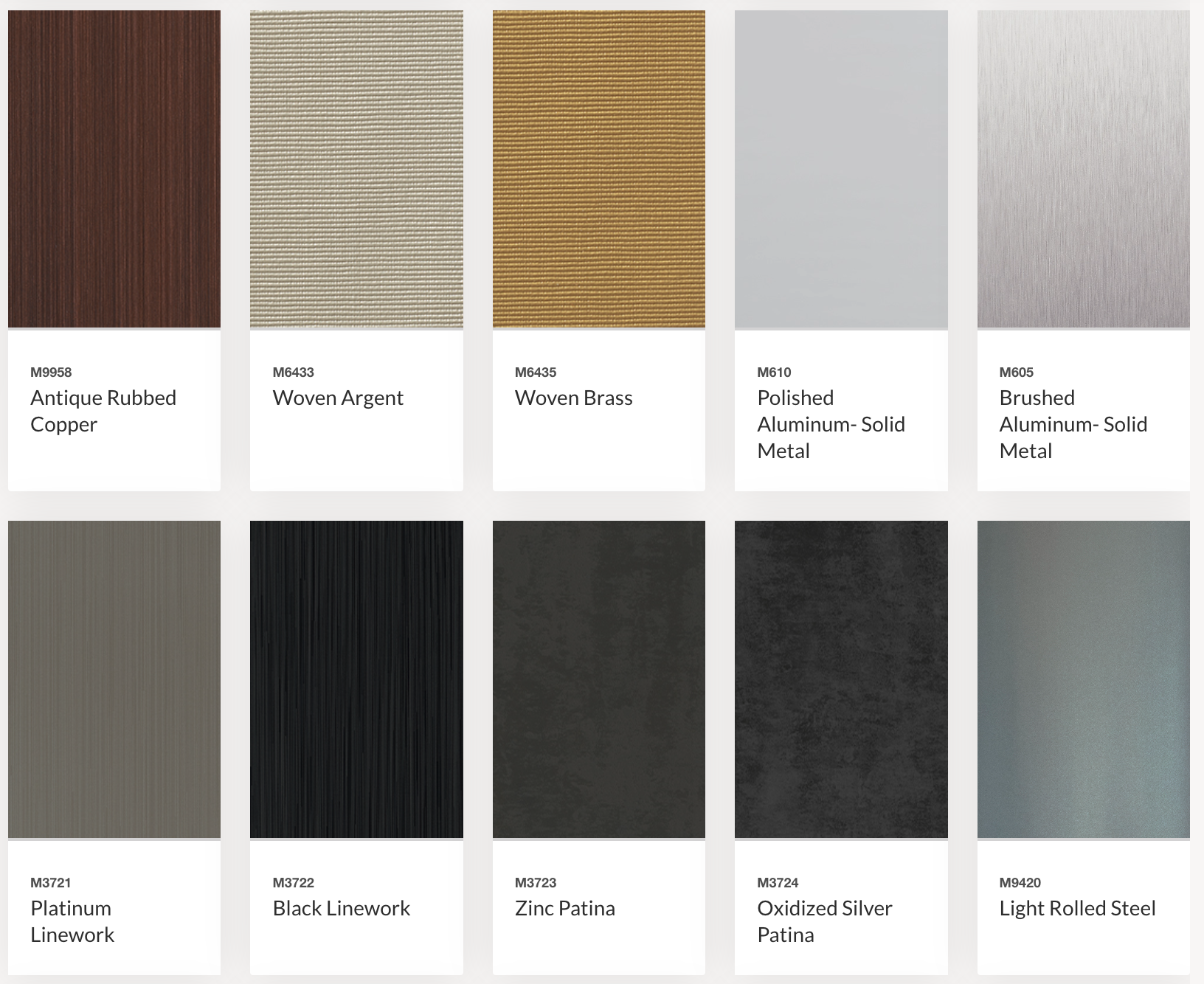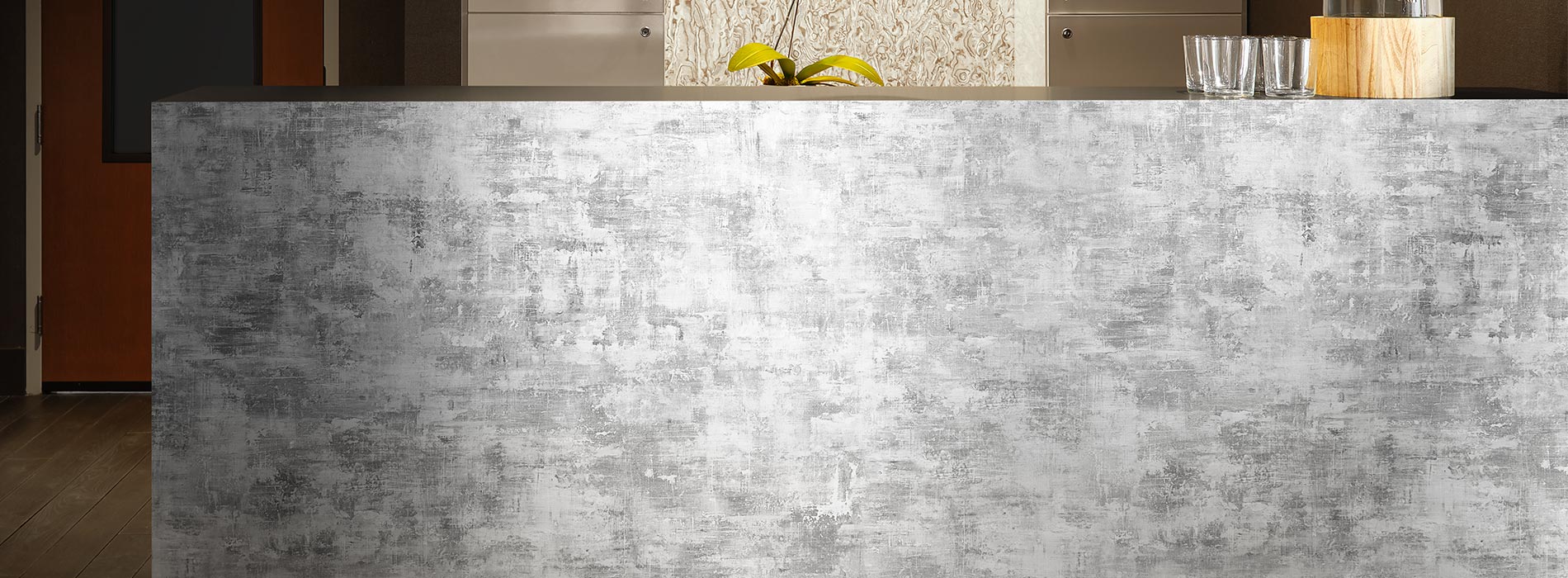Upscale hospitality spaces are a challenge for interior architects and designers. Guests expect that the décor will be elegant and beautiful, contributing to an ambience of luxury, but the materials used must complement a variety of design aesthetics while also being durable. Ideally, these qualities should be blended into a refined-appearing and easy-to-maintain material.
DecoMetal® by Formica Corporation perfectly fits the bill. AEC firms working on commercial hospitality projects will find that this product creates stunning vertical spaces in environments like hotel lobbies, conference centers, and high-end office buildings. DecoMetal® can be used on walls, furniture, displays, signage, exhibits, and even on front of or behind hospitality desks to create a stunning first impression for guests entering the property.
A Designer’s Dream for Lustrous Color and Sheen
Available in 45 different textures and colors, these metal finishes can enhance the aesthetic of any design concept. These include a variety of rubbed metals, modern industrial styles, woven textures, brushed and polished surfaces, rolled steel, satin aluminum, and many more, in colors ranging from mirror-like silver to linen-textured black, and everything in between. These designs are available in two versions: DecoMetal® laminate, which consists of metal foil laminated over a phenolic core; and DecoMetal® solid metal aluminum sheets, with polished or brushed, lacquered surfaces.
- The popular DecoMetal® line was recently extended with the addition of five new selections to the existing Rubbed Brass collection and an all new Metallic series, featuring patterns with artistically aged and patinated cross-brushing and expansions.
- DecoMetal® sheets are available as four- by eight-foot or four- by ten-foot panels and are finished with a protective coating that enhances their durability on vertical surfaces, essential in busy hospitality environments.

No matter if the interior space is ultra-modern, neo-industrial, traditional, contemporary, or something eclectic and unexpected — beautiful metallic surfaces heighten the sense of elegance. From dark patina for a clubroom-style aesthetic to a bright gold polished aluminum evoking a ballroom — if a decorator can imagine it, there’s a finish for that.
DecoMetal® as a Design Element
Meghan Howell, Creative Director at Formica Corporation, provides a couple of examples that illustrate how DecoMetal® can be used to craft a stunning interior. “I once saw our M9428 Copper Stainless as a dramatic curved wall that separated a bar from the main dining area in a restaurant,” she relates. “As the day progressed, the DecoMetal® caught and reflected the changing natural light, creating an almost kinetic effect.”
There are endless other possibilities, given the number of available finishes. She adds, “One of my favorite applications was a boutique wine bar that was attached to a trendy hotel. M8422 Black Patina, with its dark, antiqued texture, was applied to adjustable panels that were movable to create a series of intimate dining nooks. These could also be opened to frame a large community dining table.” She notes that the patina of the metal added depth and character to the space while still being functional.
This combination of beauty and practicality makes DecoMetal® an essential part of an interior designer’s toolkit for hospitality design, she observes. “You get the luxe and sparkle of the real metal foil without the weight of a solid metal panel.”
For designers considering how to best take advantage of the unique features of DecoMetal®, Howell suggests, “Consider your lighting and how it will interact with the surface to get the full ‘wow’ effect you’re looking to create. And think beyond the flat surface — don’t limit the application to merely straight walls.” Instead, she suggests applying it to a curved wall, sculptural accent, or decorative room dividers.
How to Maintain DecoMetal® Applications
The luxurious appearance of DecoMetal® doesn’t mean it is hard to clean and maintain — in fact, it’s quite the opposite. This is an important consideration in high-traffic areas like commercial environments, where numerous people may be touching and brushing up against it.
DecoMetal® is easily cleaned with a damp cloth and mild detergent. For disinfecting, bleach or isopropyl alcohol will work well without damaging the surface. After cleaning or disinfecting, simply rinse the DecoMetal® with warm water and dry it, which will allow it to retain its original luster and beauty after repeated cleanings.
Premium Craftsmanship Shines Through
Howell notes that both DecoMetal® metal laminate and DecoMetal® solid metals are beautiful solutions for interior hospitality projects, although she recommends solid metal laminate when the intended application presents a tighter, curved radius.
The elegance of DecoMetal® and the wide palette of available colors and finishes make it an easy choice for commercial architects and designers looking to incorporate high-end elements within hospitality environments. And because of its easy maintenance, it’s a natural choice for facility owners as well.
Related Stories
| Dec 10, 2013
Modular Pedia-Pod: Sustainability in healthcare construction [slideshow]
Greenbuild 2013 in Philadelphia was the site of a unique display—Pedia-Pod, a modular pediatric treatment room designed and built by NRB, in collaboration with the editors of Building Design+Construction, SGC Horizon LLC, and their team of medical design consultants.
| Dec 3, 2013
Creating a healthcare capital project plan: The truth behind the numbers
When setting up a capital project plan, it's one thing to have the data, but quite another to have the knowledge of the process.
| Nov 27, 2013
Pediatric hospitals improve care with flexible, age-sensitive design
Pediatric hospitals face many of the same concerns as their adult counterparts. Inpatient bed demand is declining, outpatient visits are soaring, and there is a higher level of focus on prevention and reduced readmissions.
| Nov 27, 2013
Exclusive survey: Revenues increased at nearly half of AEC firms in 2013
Forty-six percent of the respondents to an exclusive BD+C survey of AEC professionals reported that revenues had increased this year compared to 2012, with another 24.2% saying cash flow had stayed the same.
| Nov 27, 2013
Wonder walls: 13 choices for the building envelope
BD+C editors present a roundup of the latest technologies and applications in exterior wall systems, from a tapered metal wall installation in Oklahoma to a textured precast concrete solution in North Carolina.
| Nov 26, 2013
Construction costs rise for 22nd straight month in November
Construction costs in North America rose for the 22nd consecutive month in November as labor costs continued to increase, amid growing industry concern over the tight availability of skilled workers.
| Nov 25, 2013
Building Teams need to help owners avoid 'operational stray'
"Operational stray" occurs when a building’s MEP systems don’t work the way they should. Even the most well-designed and constructed building can stray from perfection—and that can cost the owner a ton in unnecessary utility costs. But help is on the way.
| Nov 19, 2013
Pediatric design in an adult hospital setting
Freestanding pediatric facilities have operational and physical characteristics that differ from those of adult facilities.
| Nov 19, 2013
Top 10 green building products for 2014
Assa Abloy's power-over-ethernet access-control locks and Schüco's retrofit façade system are among the products to make BuildingGreen Inc.'s annual Top-10 Green Building Products list.
| Nov 18, 2013
6 checkpoints when designing a pediatric healthcare unit
As more time and money is devoted to neonatal and pediatric research, evidence-based design is playing an increasingly crucial role in the development of healthcare facilities for children. Here are six important factors AEC firms should consider when designing pediatric healthcare facilities.

















